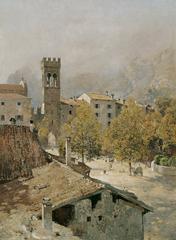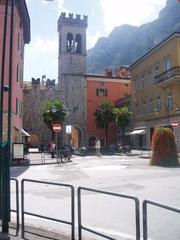Archaeological Area of Mount San Martino: Visiting Hours, Tickets, and Travel Guide
Date: 14/06/2025
Introduction: The Significance of Mount San Martino
Rising above Lake Garda near Riva del Garda, the Archaeological Area of Mount San Martino is a unique site that encapsulates thousands of years of human history. Situated approximately 800 meters above sea level, this location has served as a vital crossroads for prehistoric communities, Iron Age worshippers, Roman settlers, and medieval villagers. Its panoramic vantage point, overlooking ancient routes between Alpine passes and the Po Valley, reflects its enduring strategic and cultural importance (archeosanmartino.it; gardatourism.it).
Today, visitors can explore Roman monumental staircases, medieval church remains, and fortifications, all while enjoying sweeping views and the tranquility of chestnut woods. Free year-round access, QR-coded interpretive panels, and 3D reconstructions make Mount San Martino an engaging destination for all ages and interests (gardatrentino.it; archeotrentino.it). The site is deeply woven into local traditions, supported by community-led preservation, seasonal festivals, and educational initiatives (gardatrentino.it; academia.edu). Whether you hike, drive, or use public transport, Mount San Martino offers a memorable journey through the cultural heart of the upper Garda region.
For planning assistance and the latest information, official resources and visitor centers are at your disposal (archeosanmartino.it; gardavisit.it).
Table of Contents
- Introduction
- Historical and Archaeological Significance
- Visiting Mount San Martino: Practical Information
- Site Description and Visitor Experience
- Practical Visitor Information and Accessibility
- Mount San Martino: Cultural Context and Community Engagement
- Sustainable Tourism and Visitor Engagement
- FAQ
- Conclusion and Call to Action
- References and Further Reading
Historical and Archaeological Significance
Prehistoric and Iron Age Occupation
Mount San Martino’s lofty perch offered a natural stronghold and lookout, attracting continuous human activity since the pre-protohistoric era (archeosanmartino.it). Archaeological evidence places early settlements here, drawn by defensibility and control over ancient travel routes.
During the late Iron Age (3rd–1st century BCE), the site became a religious center, as evidenced by ritual objects and structures associated with ceremonial practices. Its elevation and prominence would have contributed to its role in regional spirituality.
Roman Sanctuary and Settlement
Transformation came at the end of the 1st century BCE, when the Romans constructed a sanctuary complex atop earlier cult sites. Active for over two centuries, this sanctuary featured monumental architecture and functioned as a place of worship and pilgrimage (gardatourism.it). Finds from this era include altars, imported ceramics, and votive offerings, highlighting Mount San Martino’s integration with wider Roman trade and cultural networks.
Late Antiquity and Early Medieval Developments
With the sanctuary’s decline, a new settlement emerged (4th–6th centuries CE), likely serving military or logistical purposes. The Christianization of the area is marked by the construction of a small church dedicated to Saint Martin, confirmed by written sources from the 13th century and used for ceremonies until 1750 (archeosanmartino.it).
Medieval Village and Fortifications
The medieval era saw the development of a fortified village, with defensive walls and a church anchoring community life. Archaeological finds include burials, cisterns, and ceramic fragments, illuminating daily existence and artistic production. The church later became associated with a monastery and hospital, reflecting evolving social and religious dynamics (gardatourism.it).
Archaeological Research
Ongoing excavations at Mount San Martino provide insight into settlement patterns, religious practices, and responses to environmental events from the Copper Age onwards (archeosanmartino.it). The site serves as a reference for understanding the region’s long-term cultural evolution.
Visiting Mount San Martino: Practical Information
Visiting Hours
- Open year-round; best visited during daylight hours (typically 9:00 AM–6:00 PM).
- Guided tours offered from April to October—confirm schedules in advance.
Tickets and Guided Tours
- Free entry to the site; no ticket required.
- Guided tours are available (April–October) and may require advance booking and a small fee.
Accessibility
- Access is via a mountain trail (about 15 minutes from Campi), with uneven and sometimes steep terrain.
- Not wheelchair or stroller accessible; visitors with mobility challenges should assess the route before visiting.
Travel Tips
- By Car: Free parking at the trailhead near Campi.
- By Public Transport: Local buses connect Riva del Garda to Campi (check current timetables).
- On Foot/Bike: Well-marked hiking and cycling paths from Riva del Garda or Lake Tenno.
- Best Time: Spring and autumn for weather and scenery.
- What to Bring: Hiking boots, water, sun protection, and layered clothing.
On-Site Amenities
- Restroom facilities at a service hut near the site.
- Interpretive panels in Italian and German with QR codes for additional content.
- Wooden sculptures and artistic installations along the trail (archeotrentino.it).
Site Description and Visitor Experience
Layout and Main Features
- Roman Sanctuary: Monumental staircase and temple platform, with panoramic views (Garda Trentino).
- Late Antique Settlement: Remains of public buildings, workshops, and storage facilities.
- Medieval Church of San Martino: Ruins and churchyard with medieval burials.
- Interpretive Trail: Numbered panels, QR codes, and 3D visualizations guide visitors through the site.
Points of Interest
- Chestnut Groves: Scenic especially in autumn, with local chestnut festivals.
- Photographic Spots: Panoramic vistas over Lake Garda and surrounding mountains.
Safety
- Weather can change rapidly; check forecasts and bring appropriate gear.
- Trail may be slippery after rain; hiking shoes are essential.
- Inform someone of your plans if hiking alone.
Practical Visitor Information and Accessibility
- Trails are not wheelchair accessible due to rocky and uneven surfaces.
- No food or vending services on-site; bring your own refreshments.
- Nearest amenities are in Campi or Riva del Garda.
- MAG Museum in Riva del Garda displays site artifacts and offers accessible multimedia exhibits (MAG Museum).
Mount San Martino: Cultural Context and Community Engagement
Integration with Local Traditions
- Saint Martin festivals in November feature processions, communal meals, and guided walks to the site.
- Chestnut harvesting and rural markets reflect the region’s agricultural heritage (Garda Trentino).
Community Preservation
- Residents of Campi and local associations work with tourism boards on site stewardship, sustainability, and educational outreach (academia.edu).
Sustainable Tourism and Visitor Engagement
- Well-marked walking and cycling trails promote eco-friendly access.
- Workshops and public archaeology programs encourage visitor participation in research and conservation.
- Interpretive materials are multilingual and visually accessible.
Frequently Asked Questions (FAQ)
Q: Is there an entry fee?
A: No, Mount San Martino is free to visit year-round.
Q: What are the opening hours?
A: The site is open during daylight hours; guided tours are typically available April–October.
Q: How do I get there?
A: By car (parking at Campi), public bus, or hiking from Riva del Garda or Lake Tenno.
Q: Is the site accessible for people with disabilities?
A: Not fully; trails are uneven and steep. Alternative experiences available at MAG Museum.
Q: Are guided tours available?
A: Yes, bookable through local associations and the MAG Museum.
Q: Can I take photos?
A: Yes, on marked paths; drone use requires special permission.
Conclusion and Call to Action
Mount San Martino stands as a living testament to the rich history and natural beauty of the Garda Trentino region. Its free access, immersive interpretive features, and ongoing cultural events make it an essential stop for history enthusiasts, hikers, and families alike. Prepare adequately, respect the site, and take time to explore the wider area—including the MAG Museum, Lake Tenno, and Canale di Tenno—for a truly enriching experience.
For the latest updates, guided tours, and interactive content, download the Audiala app and consult official tourism websites. Engage with local culture, participate in festivals, and become part of the ongoing story of Mount San Martino.
References and Further Reading
- Archeo San Martino – Official Site
- Garda Trentino – Archaeological Area San Martino in Campi
- Archeo Trentino – Area Archeologica San Martino ai Campi
- Garda Visit – Riva del Garda Things to Do and See
- Garda Trentino – From Lake Tenno to San Martino Archaeological Site in Campi
- Academia.edu – Monte San Martino, Riva del Garda (N. Pisu, E. Possenti)
- MAG Museum
- Garda Tourism – Area Archeologica Monte San Martino

